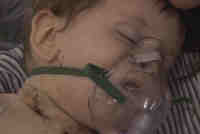Tahlia Lovegrove
Long Segment Tracheal Stenosis

Great Ormond Street Hospital doesn't have an accident and emergency department, so when a child arrives in an ambulance it's a special case. One year old Tahlia Lovegrove has been rushed to the critical care unit. Her anxious parents, Alison and Paul, can only look on as their daughter is kept alive by a life-support machine.
Tahlia's condition became critical when she woke up at her home, in Brighton, struggling to breathe. She has an extremely rare disease called Long Segment Tracheal Stenosis. It means her windpipe, or trachea, is so narrow that she can hardly breathe. This life-threatening condition can be present at birth or acquired from trauma or infection.
Tahlia has been rushed to Great Ormond Street Hospital in London as it's the only hospital in the UK that treats this condition. She'll be looked after by one of the top paediatric heart and lung surgeons in the country. Professor Martin Elliot has worked at the hospital for the past twenty years. His tracheal team is world-famous.
Up until recently, many children died from Tahlia's condition, but Professor Elliot and his team have changed all that. Six years ago they developed a revolutionary surgical technique that shortens and widens the trachea. Tahlia's surgery will be a challenge for Professor Elliott , her trachea is so narrow that he hasn't been able to get a camera inside to take a proper look. Hw wont know the full extent of her problem until the surgery is underway.

Prof. Martin Elliott
As the team begin the surgery, it takes them an hour to locate Tahlia's trachea. Professor Elliott explains the difficulty "The trachea is buried deep in the chest near the back and it's within a lot of blood vessels, the aorta leaving the heart and the main vein draining into the heart. Immediately, you generate the need for complexity".
Once Tahlia's trachea has been cut there's no going back. The narrow part of the trachea is cut in half then sliced open. The split narrow sections are then overlapped and stitched together making it shorter and wider. Before they cut they must be certain there is enough movement to permit the necessary overlap.
Molly's trachea has a diameter of 1.8mm, the normal trachea should be between six and eight millimetres, over three times the size of Tahlia's.
The two sections of the narrow trachea are carefully stitched and pulled together. When the stitching is complete, the join is sealed with special tissue glue. The surgery has taken five hours.
Tahlia will be kept sedated and paralysed for the next 48 hours to give her trachea time to heal. Her next big challenge will be when doctors remove her breathing tube to see how well she can breathe on her own.
Intensive care consultant Dr Mark Piggott will be responsible for removing Tahlia's breathing tube. It should be straight forward, but there's a problem. The tube is stuck and he's not prepared to pull harder until he's had a look with a bronchoscope.
The investigation revealed that one of the stitches in her trachea was holding the tube in place. It was successfully removed overnight, but Tahlia's not breathing well on her own yet and is very agitated. The next few days are going to be crucial.
Now that she is learning to breathe on her own again, the strength of the trachea will be put to the test. After five days, she is well enough to leave intensive care and move into ladybird ward. Tahlia's biggest challenge now is to withdraw from the morphine that has been keeping her pain at bay for the last two weeks.
Back home in Brighton, two months later, Tahlia is doing well.
CREDITS: All of this information came from the UK Channel 5 "Child in a Million" documentary series

